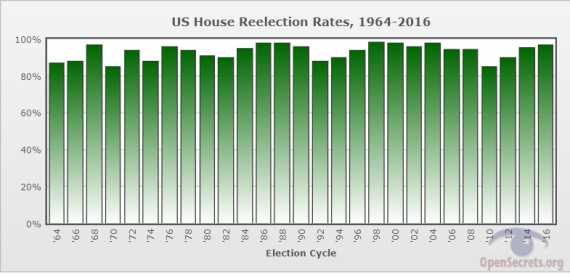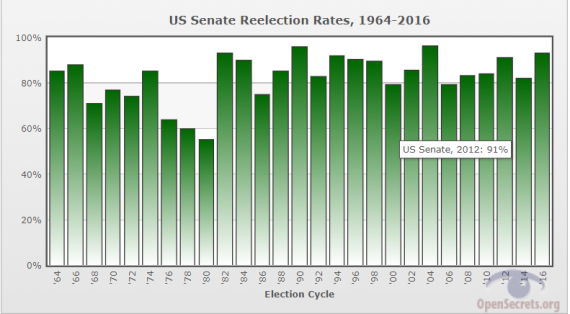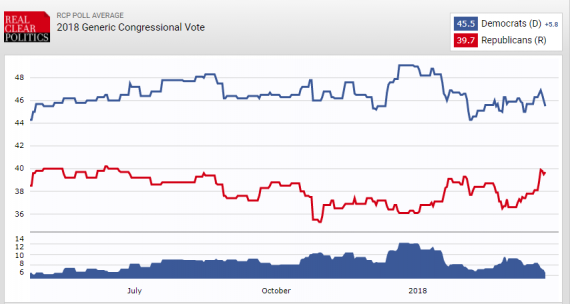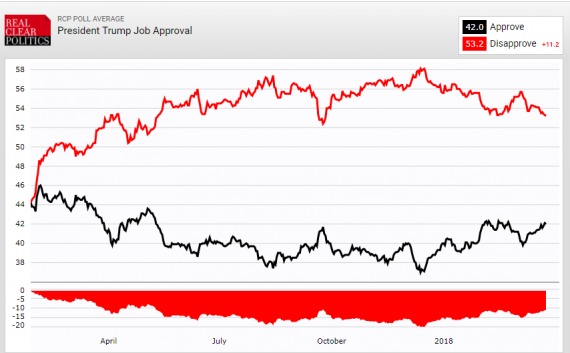Democrats Need A Big Wave To Take Back The House. They Might Not Get It.
If the polls are any indication, Democrats may fall short in their bid to take back the House in November.
A new report indicates that Democrats would need a wave unlike anything we’ve seen in politics in four decades in order to take back control of the House of Representatives in the upcoming midterm election:
A report released Monday suggests Democrats might have to temper their enthusiasm about climbing back to power during this year’s midterm elections.
To win a majority in the U.S. House of Representatives, Democrats would need a tremendous electoral wave not seen in more than 40 years to overcome Republican advantages from gerrymandered districts in key states, according to an analysis from the Brennan Center for Justice.
The report projects that Democrats would need to win the national popular vote for congressional districts by a nearly 11 percentage point margin over Republicans to gain more than the roughly two dozen seats they need to flip control of the Republican-led chamber.
That would take more than the typical Democratic wave that history suggests would occur for the party out of power during a midterm election.
“It would be the equivalent of a tsunami,” said Michael Li, a senior counsel who heads up redistricting work for the center, which is based at New York University School of Law. “Democrats would have to win larger than any sort of recent midterm wave — almost double what they got in 2006 — in order to win a narrow majority.”
The Brennan Center opposes what it calls “extreme gerrymandering” in which political parties draw legislative districts that virtually ensure they will hold on to power.
The center has filed a court brief in a case to be heard Wednesday by the U.S. Supreme Court supporting a lawsuit by Republicans alleging that Maryland’s former Democratic governor and legislature unconstitutionally gerrymandered a congressional district to their advantage.
It also has filed court briefs supporting Democratic lawsuits alleging unconstitutional partisan gerrymandering by Republicans in states such as Wisconsin and Pennsylvania.
The center’s analysis notes that Democrats gained 31 seats when they won the national congressional vote by 5.4 percentage points in 2006. Yet under the current districts, which were redrawn after the 2010 Census under GOP control of many state capitols, a similar national victory margin in the November election is projected to net Democrats only about a dozen new seats.
The report projects that a 10 percentage point national margin would gain 21 seats for Democrats — still shy of the 23 or 24 needed to claim a House majority. An 11-point margin is projected to gain 28 seats for Democrats, but they haven’t achieved such a large midterm victory since a nearly 14 point margin gained them 49 seats in 1974.
“Even a strong blue wave would crash against a wall of gerrymandered maps,” the Brennan Center report says.
The analysis is based on an assumption that as a political party increases its share of the statewide vote, it will see a similar percentage increase in most congressional districts. The report does not account for particular factors at play this year in each district, such as whether incumbents are retiring or whether voter demographics have shifted.
To a large degree, of course, the difficulties that Democrats may have ahead of them in winning back control of the House are rooted in the fact that there are far fewer competitive districts around the nation than there have been in the past. While it’s likely true that a good part of this is attributable to district lines that have been drawn in ways that favor one political party over another, that clearly isn’t the only factor making the road ahead so difficult for Democrats. Historically speaking, it’s simply a fact of the matter that incumbents running for re-election have a tremendous advantage over challengers that applies regardless of how partisan an individual district’s composition may be. As this chart from Open Secrets that shows House re-election rates from 1964 to 2016 shows, for the House of Representatives the re-election rate has in recent years been somewhere between 90 and 97%, and has only fallen below 90% on a few very limited occasions:
The numbers are a bit different from the Senate, but they also show that the percentage of incumbent Senators re-elected has seldom dropped below the high 80% range at any more since the 1980 election when Republicans took back control of the Senate for the first time since the 1950s:
While Democratic efforts to retake the House may be made easier to some extent by the number of open seat elections made possible by the decision of roughly 23 Republican members of the House to decline to run for re-election, these numbers suggest that winning the number of seats that it would take to get even a bare majority in the House is not going to be quite as easy as many Democrats may hope or expect.
Looking at the numbers today, there doesn’t appear to be much of evidence of the kind of wave that Democrats would need to win back the House, at least not yet. The two most recent Generic Congressional Ballot polls from Fox News Channel and Marist College, for example, both show that the Democratic advantage in the nationwide poll has shrunk to five percent, lower than it was in both polls in past iterations. The polling averages aren’t pointing in the Democrats direction sufficiently to show the existence of a wave that could win back the House for them. The RealClearPolitics Generic Congressional Ballot, for example, gives Democrats (45.5%) a 5.8 point advantage over Republicans (39.7%). The Pollster average meanwhile gives Democrats (42.9%) a 5.4 point advantage over Republicans (37.5%). Finally, the FiveThirtyEight average gives Democrats (46.0%) a 5.7 point advantage over Republicans (40.3%). While these numbers are all positive in the Democratic Party’s favor, it’s far short of where the numbers would generally need to be for the Democrats to have the kind of wave they need to win the House back. Perhaps of most concern for Democrats, though, is the fact that the gap between the two parties have been closing recently as we can see in this chart from RealClearPolitics:
In addition to the Generic Congressional Ballot, another factor that is likely to play an important role is what the public thinks about the job that the President is doing. In that respect, things aren’t substantially different from where they have been for the better part of the past year, and to some extent we’ve actually seen President Trump’s number improve to some degree. Looking again at the Fox News and Marist polls noted above, those polls show the President with a seven-point and nine-point deficit between disapproval and approval respectfully. These numbers contrast with the most recent Gallup poll which shows the President’s disapproval at 55% while his approval stands at 39%, a deficit of 16 points. Other polling from The Economist and YouGov and Quinnipiac both show a 13 point deficit.
The averages, meanwhile, are about where they have been for quite some time now. RealClearPolitics, for example, has the President’s approval at an average of 42.0% and disapproval at 53,2%, making for an 11.2 point deficit. Pollster meanwhile shows the President’s job approval at 43.1% and disapproval at 52.7% for a deficit of 9.6 points. Not surprisingly, Trump’s numbers are overwhelmingly negative among Democrats and overwhelmingly positive among Republicans. Among independents, Trump’s numbers remain worse than among the general population with 35.8% approving of the job the President is going and 55.9% disapproving, making for a deficit of a rather astounding 20.1%. Finally, FiveThirtyEight’s average shows the President at 40.8% approve and 53.5% disapproval, making for a deficit of 12.7 points. Looking at the chart, there does seem to be some indication that the gap between the President’s approval and disapproval is closing just a bit:
Again, while these numbers seem positive for Democrats they don’t indicate the kind of wave they would need to win back the House. Perhaps that will change over the next seven months as the election gets closer, but so far at least it doesn’t appear that the momentum for a wave is out there.






Running on Gun Control/Safety/Reform that is supported by over 95% will guarantee the Democrats take the House and Senate.
I have already accepted that the road to ridding us of Trump may not run through the Democratic party, which seems counter-intuitive since he’s a Republican, but partisanship being what it is, that’s probably how it will go. They’ll need to get sick of him, then send him packing.
Rebuilding the Democratic party* is going to take a few more years and a couple of election cycles.
* I know, I know….not everyone agrees with me on whether the Dems need to be rebuilt, but we just ended a 20 year period where a lot of energy was wasted trying to pave the way for President Hillary Clinton. In the meantime, we left a lot of things undone and our infrastructure has atrophied.
With the sheer amount of crap that has happened, in just the last week alone…totally unforced, by the way…it’s just way to early to even try to predict where we will be in November.
Mueller is bound to have something to say.
Statistically speaking…we are bound to have a recession.
Dennison/Bolton are likely to start a war in which 20,000 people a day die.
China is likely to retaliate against Dennison’s nonsensical tariff’s.
Who knows what might happen we can’t even imagine yet?
@James Pearce: Honestly, I think a lot of it is attributable to the state and local party organizations atrophying during the Obama administration. Howard Dean had done a lot of work to rebuild them and then he was removed after Obama took office. The current DNC chair has been making all the right noises and he’s been trying to clean house, but I don’t know if he’s going to be able to get the state parties ready for November 2018.
It’s 36. 24 outright retiring (Costello announced he’s retiring from PA-6 this morning), 7 quitting to run for Senate, 5 quitting to run for Governor
They need a large wave due to gerrymandering. The effective disenfranchisement of millions of Americans is what is protecting the GOP majority in the House.
Lots of time between now and November, but I agree it doesn’t look good. Any major trumpian blunders will likely take more time than that to have an effect (and that is a good thing). Overall Trump has shown himself to be a tepid leader, when he bothers to lead at all, saving any and all fire for Tweeter. His disinterest in policy menas he does little, and what little he does is done incompetently.
That’s all good for a mean-spirited, spiteful politician.
Now the bad:
I don’t think he wants to start any wars (yet). But that doesn’t mean he won’t. His patent ignorance of policy could convince him that a “bloody nose” strike on North Korea won’t lead to a war, and even that the Kim regime won’t respond at all. Ditto for trashing the Iran deal.
For all that, he’s most likely to start a war from mid-2019 onward, when his popularity is even lower, the economy won’t be doing so well, and he sees his chances at reelection diminishing by the day. Then he might start a war as a measure to recover popularity.
To echo Darryl above, what happens if some kind of bombshell is dropped from Mueller’s investigation before November? All bets might be off at that point…
The reality is that so long as the House remains biased towards rural and low population states, the Republicans will have the advantage.
More so than gerrymandering, the fixed cap on House seats (since 1929) all but guarantees Republican control of the House for the foreseeable future. About the only thing that could change that is an all-out trade war with China where they basically shut down the majority of their US agriculture imports. And even in that case, it most likely will only be for two to four years.
The reality is that so long as the House remains biased towards rural and low population states, the Republicans will have the advantage.
The House is redistricted every 10 years with inevitably fewer seats in “rural and low population” states. You’re getting it confused with the Senate. And while gerrymandering absolutely plays a role in GOP control of the House, it’s aiding and abetted by Democrats essentially abandoning the battlefield. There are plenty of districts where an at-least-nominally culturally conservative Democrat could be competitive but the Party decided it didn’t want candidates like that.
Mike
@An Interested Party: Yes. I am expecting a bombshell concerning the Democratic Party leadership and the primary fixing fiasco. That is what we will see.
@MBunge:
What Matt was saying is factually correct, and it’s been discussed here many times. A couple of weeks ago I linked to a 2014 NYT article which goes into some detail about the problem:
@Kylopod:
You’re wrong and the article you linked to proved you’re wrong. There’s nothing in that article about the House being biased toward rural and low population states. The House of 2018 is the same House that Democrats controlled for two generations in the latter half of the 20th century. The only change has been redistricting that has meant fewer seats in rural and low population states and more seats in urban and high population seats.
What the article states is almost exactly what I wrote, that Democratic problems in winning the House are largely tied to their own decision to write off and ignore entire areas of the country and entire segments of the population.
And by the way, when Republicans won the popular vote in five out of six Presidential elections, should we have changed the rules so they won more seats in the House and Senate? House districts all have the same population. What you want is for House districts Dems win 80% to 20% to be more important than districts the GOP wins 52% to 48%, which means you don’t really understand what the U.S. system is and why it is that way.
To try and dumb it down for you, Hillary Clinton won the popular vote in California and Donald Trump won the popular vote in the other 49 states combined. You want her win in one state to override his win in the other 49. That might be momentarily good for Democrats but there’s no way it can sustain a 50 state union.
Mike
@MBunge:
Speaking of dumbing it down, this may be the stupidest argument on this topic.
It is equally possible to note that if you take out Texas’s electoral votes, HRC would have won the Electoral College. You want him to win in one state overriding her win in the other 49? That might be momentarily good for Republicans but there’s no way it can sustain a 50 state union.
Damn you are stupid…
Seriously, California has 12% of the United States population. What possible argument can anyone sane make that their votes shouldn’t count?
@MBunge:
You’re guaranteed a representative no matter how small in population your state is. So as the US population grows and we refuse to add congressional districts you end up with disparities in the population size of congressional districts. Disparities that favor low population states.
@SKI:
I’m not the one arguing anyone’s votes shouldn’t count. What I’m pointing out is that the electoral rules we have now are the same ones we had when Dems controlled Congress and the GOP won the White House for 20 out of 24 years.
Let’s try another analogy for the cognitive-impaired. It is possible to win a game of Monopoly while owning fewer properties than your ultimate opponent. If the guy losing with the most properties starts whining and demanding that owning the most properties is all that matters, should the rules be changed to let him win? Why would anyone else bother playing the game?
Mike
@MBunge:
The reality of having seat capped at 435 is that it necessarily biases more power towards rural and less populated states. More populated states and denser urban areas — both that tend liberal/democratic — are ultimately under represented in the House.
Something like the Wyoming rule would allow for more equitable population based representation. Which was the original intent of the House.
Note also that the House has long since been “representative” of our population, regardless of party. And the artificial cap on seats is far greater contributor that any sort of gerrymandering (be it intentional or the results of simple demographics).
Trying to argue against that is simply being disingenuous.
For more on this, drawing from the wayback machine:
https://www.outsidethebeltway.com/representation-in-the-house-the-wyoming-rule/
https://www.outsidethebeltway.com/435-representatives-unconstitutional/
@Console:
If we add House seats, we would be adding them EVERYWHERE. There would be more in Red States and Blue States, more in New York and more in Texas, more in California and more in Iowa. Urban areas already have far more House seats than rural areas. simply adding more seats in both doesn’t change anything.
Mike
@mattbernius:
I wrote about one proposal to expand the size of the House of Representatives several years ago.
@SKI:
By the way, you are also wrong in that Trump would have still had more electoral votes than Hillary without Texas.
Mike
@mattbernius: More populated states and denser urban areas — both that tend liberal/democratic — are ultimately under represented in the House.
Again, they are only underrepresented if you think winning a House district 80% to 20% should win you an extra seat compared to a district that’s won 55% to 45%. That’s not how our system works. That’s NEVER been how our system works. In fact, our system is the way it is to discourage the kind of regionalism/factionalism you are advocating.
Mike
@SKI:
If you take Texas’s 38 Electoral Votes and give them to Clinton instead of Trump, the total EV vote would have been:
Trump: 270
Clinton: 268
In other words, Trump would have won a narrow Electoral College victory without Texas.
Going back to the original post by Doug, let’s take a moment to ponder how broken a system is that one party has to win the overall votes by more than 6% to claim a majority of the legislature. Regardless of the academic discussion of rural/urban (more on that in a second below), we have to question whether that type of inequity and unbalance is sustainable.
In MB’s idiocy above he talked about the 50 State Union. At some point, if this imbalance between population and representation continues to get worse, we will be forced us to grapple with the question of whether we are a union of 50 states or a singular country.
Ok, on rural/urban: the received wisdom from the folks who study this claims that his discrepancy is a material factor – separate and apart from gerrymandering – in why Democrats need a larger percentage of the vote to gain the majority. This explanation/theory is based on (a) the factual reality regarding population density in an urban environment and (b) the claim that the partisanship balance in the urban areas is materially more intense than in rural areas. They therefore conclude that is is therefore impossible to draw districts that accurately reflect the overall popular will because the D’s have congregated into dense cities. While the first assumption is indisputable, the second doesn’t ring true to me in that there are Rural areas that are just as heavily R as the cities are D.
Let me suggest that the real issue is suburbia and the concept of compactness. The suburbs are markedly less partisan than the cities or the rural areas. They are the part that is being gerrymandered by adding rural areas to them to make a bunch of them reliably R while the urban areas are restricted in the name of “compactness”. If the suburbs stay mostly split, perhaps slightly R, then the “principal” of compactness will mean an inherent GOP advantage.
However, there is no reason that compactness needs to be prioritized. The real issue in representation is just that – representation. Does the district held together around shared regional interests? What are the “communities of interest”? – a factor many states require to be considered in drawing districts. Maybe it is commuting patterns? Maybe its something natural like the Chesapeake Bay or the Great Lakes? The bottom line is that the border for a district should make sense. Each district, or clump of districts in the case of a more populous area, should be tied together somehow.
@Doug Mataconis: Not enough coffee this morning.
Regardless, the underlying point holds. It is idiotic to think/claim that the votes from a particularly populous state shouldn’t count.
@Doug Mataconis:
You’ve got it backwards. Trump won 306 electoral votes, Hillary 232 (let’s ignore the faithless electors on both sides for now). Now let’s do the math:
Trump: 306 – 38 = 268
Clinton: 232 + 38 = 270
So yes, flipping Texas alone, without changing anything else on the electoral map, would have made Clinton the (narrow) winner, assuming no faithless electors on her side.
@SKI: Speaking of the suburbs…
Suburban voters angry with Trump threaten GOP’s grip on House
@Doug Mataconis:
Yup, sorry about not citing you as well in that.
@MBunge:
Yes, we would be. And that’s a good thing to do in general for better representation. However, the point would be that more populous areas will get a higher degree of representatives. The numeric result of that inevitably redistributes power away from rural areas and lower populated states towards denser population centers.
The reason to change the limit isn’t to give more power to one party or the other, but to get us towards more localized and truly proportional representation.
No, that’s fundamentally *not* what I am saying, but based on these exchanges, it’s pretty clear that we are going to continue to talk past each other. So we’ll simply agree to disagree.
I will note that this is a fundamental misreading of the concept of the House which was intended to focus on local representation. I suspect that if the founders were to learn that Congress people were on average representing districts of 700,000+ residents, they would take issue with the 1929 cap.
https://www.census.gov/prod/cen2010/briefs/c2010br-08.pdf
@MBunge:
No, because of the rule that every state should have at least 1 representative; today, some states (like Wyoming) have 1 seat in the House, not because they have population for that (they don’t) but because it is the minimum; if you add House seats, these states (who are mainly Red States) probably will remain with 1 seat, meaning that the weight of Blue States in the House will rise.